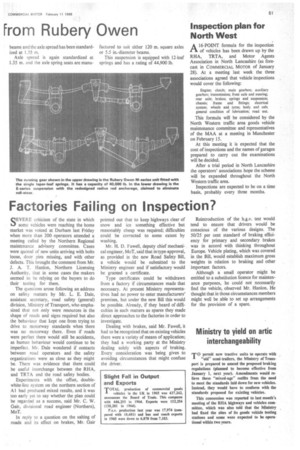Factories Failing on Inspection?
Page 53

If you've noticed an error in this article please click here to report it so we can fix it.
CEVERE criticism of the state in which some vehicles were reaching the home market was voiced at Durham last Friday when more than 200 operators attended a meeting called by the Northern Regional maintenance advisory committee. Cases were quoted of new units arriving with bolts loose, door pins missing, and with other defects. This brought the comment from Mr. J. A. T. Hanlon, Northern Licensing Authority, that in some cases the makers seemed to he relying on the buyers to do their testing for them.
The questions arose following an address on safety matters by Mr. L. E. Dale, assistant secretary, road safety (general) division, Ministry of Transport, who emphasized that not only were resources in the shape of roads and signs required but also the behaviour that kept one from trying to drive to motorway standards when there was no motorway there. Even if roads were perfect there would still be accidents, as human behaviour would continue to be imperfect. Mr. Dale wondered if contacts between road operators and the safety organizations were as close as they might be. There was evidence that there could be useful interchange between the RHA and TRTA and the road safety bodies.
Experiments with the offset, doublewhite-line system on the northern section of Al had produced mixed results, and it was too early yet to say whether the plan could be regarded as a success, said Mr. C. W. Gait-, divisional road engineer (Northern), MoT.
In reply to a question on the salting of roads and its effect on brakes, Mr. Gair
pointed out that to keep highways clear of snow and ice something effective but reasonably cheap was required; difficulties could be corrected to some extent by washing.
Mr. H. D. Fawell, deputy chief mechanical engineer, MoT, said that in type-approval, as provided in the new Road Safety Bill, a vehicle would be submitted to the Ministry engineer and if satisfactory would be granted a certificate.
Type certificates could be withdrawn from a factory if circumstances made that necessary. At present Ministry representatives had no power to enter manufacturers' premises, but under the new Bill this would be possible. Already, if they heard of difficulties in such matters as spares they made direct approaches to the factories in order to investigate.
Dealing with brakes, said Mr. Fawell, it had to be recognized that on existing vehicles there were a variety of means of application; they had a working party at the Ministry dealing solely with aspects of braking. Every consideration was being given to avoiding circumstances that might confuse the driver. Reintroduction of the h.g.v. test would tend to ensure that drivers would be conscious of the various designs. The 50/25 per cent standard of braking efficiency for primary and secondary brakes was in accord with thinking throughout Europe. Vehicle plating, which was covered in the Bill, would establish maximum gross weights in relation to braking and other important factors.
Although a small operator might be entitled to a substitution licence for maintenance purposes, he could not necessarily find the vehicle, observed Mr. Hanlon. He thought that in those circumstances members might well be able to set up arrangements for the provision of a spare.




























































































































